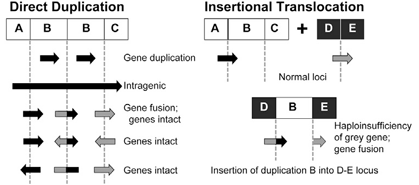Copy number variations (deletions or duplications of large chunks of the genome) are a major cause of birth defects, intellectual disability, autism spectrum disorder and other developmental disorders. Still, geneticists can definitively say how a CNV, once discovered in someone's DNA, leads to one of these conditions in just a fraction of cases.
To aid in the interpretation of CNVs, researchers at Emory University School of Medicine have completed detailed maps of 184 duplications found in the genomes of individuals referred for genetic testing. The findings were published Thursday in the American Journal of Human Genetics.
"Ours is the first study to investigate a large cohort of clinically relevant duplications throughout the genome," says senior author Katie Rudd, PhD, assistant professor of human genetics at Emory University School of Medicine. "These new data could help geneticists explain CNV test results to referring doctors and parents, and also reveal mechanisms of how duplications form in the first place."
Despite advances in "next generation" DNA sequencing, the first step for patients who are referred to a clinical geneticist is currently a microarray. This is a scan using many probes across the genome, testing if someone's DNA has one, two, three or more copies of the DNA corresponding to the probe. (Two is the baseline.) From this scan, geneticists will have a ballpark estimate of where a deletion or duplication starts and ends, but won't know the breakpoints exactly.
"In a few years, advances in sequencing will make it possible to routinely capture data on copy number variation and breakpoints at the same time," Rudd says. "But for now, we have to do this extra step."
In addition, in comparison with deletions, duplications are more complicated. The extra DNA has to land somewhere, sometimes resulting in the disruption or warped regulation of nearby genes, which make it more difficult to pinpoint particular genes responsible for the individual's medical condition.
Most healthy people have a deletion or duplication of at least 100 kilobases in size. The individuals in the study were referred for clinical microarray testing with indications including intellectual disability, developmental delay, autism spectrum disorders, congenital anomalies, and dysmorphic features. Their CNVs were larger, with an average size of more than 500 kilobases. For reference, the entire haploid human genome, with about 19,000 genes, is about 3.3 million kilobases in size.
Rudd's team examined 184 duplications, and found that most are in tandem (head-to-tail) orientation and adjacent to the duplicated area. Most of the CNVs in the study were inherited from a parent. The researchers also found examples where a duplicated gene inserted into and disrupted another gene on a different chromosome.
In a few cases, a duplicated gene was fused together with another gene. This is a phenomenon often seen in cancer cells, where a DNA rearrangement leads to an abnormal activation of a growth- or survival-promoting gene. In these cases, the fusions were present in all cells in the body and not related to cancer, but could be responsible for the patient's condition.
"These fusion genes are intriguing but we don't know, just from looking at the DNA, if the gene is expressed," Rudd says. "These findings could be the starting point for follow-up investigation."
Co-first authors of the paper are postdoctoral fellow Scott Newman, PhD and senior research specialist Karen Hermetz. The research was supported by the National Institute of Mental Health (R01 MH092902).

